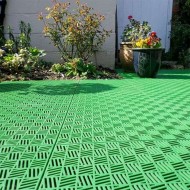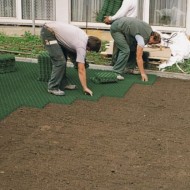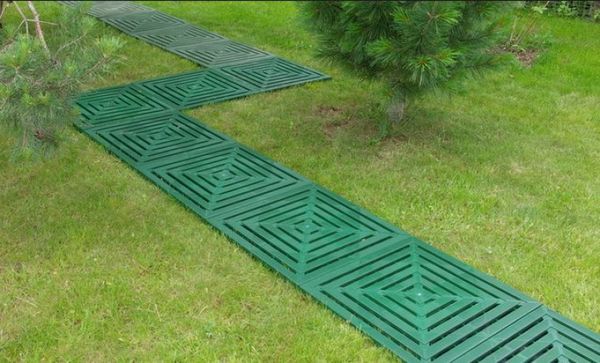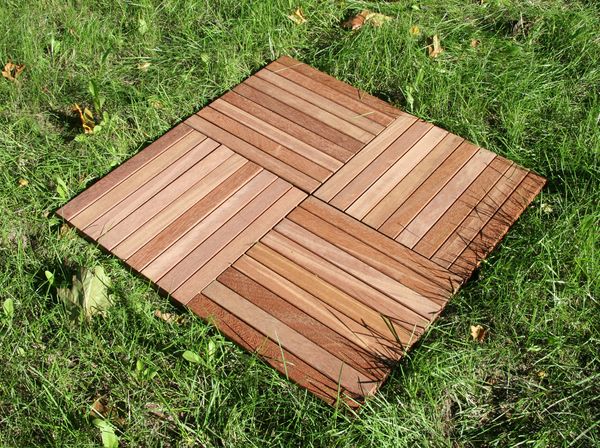Plastic garden paths: keeping the budget and decorating the infield
Content
Benefits of modular decking
Plastic tiles have the following advantages over traditional concrete paths:
- low cost, since there is no need to install a capital foundation;
- quick installation;
- if necessary, the track made of plastic coating can be moved to another place;
- low weight, thanks to which delivery can be carried out independently, without hiring a truck;
- reliability - the average permissible service life of a modular coating is 15 years.
The polymer coating as garden paths has only one significant drawback - its appearance. It is really inferior to concrete, ceramic, granite, marble coatings. That is why experts recommend using it only if the house on the site is also closed with a similar synthetic material - like siding or plastic decorative panels. Otherwise, the combination of a natural stone structure in combination with plastic paths will look just ridiculous.
Video "Durable DIY Garden Path"
From this video you will learn how to make a garden path with your own hands.
Varieties
Plastic garden paths are conventionally classified into:
- Modular coverage. In fact, this is a plastic tile that mimics ordinary concrete or ceramic. It is durable, but it loses its primary appearance rather quickly. But it is very easy to install, the soil is prepared for it literally in 15–20 minutes - you just need to level it.
- Lawn grill. Installation is even easier than modular flooring. It has a perforated structure, so it can be mounted over a lawn covering. But it is sure to fit on a powerful sand and gravel cushion, since over time it can deform (after all, it does not have a support as such, the grating is pressed into the ground).
- Plastic sand tiles. It is a kind of modified variation of the modular coating. It perfectly retains its original appearance, but at the same time it costs almost 3-4 times more.
- Decking, aka garden parquet. These are boards based on plastic and wood flour. Visually looks like wood, has a similar texture, but the base is polypropylene. The most expensive of such coatings, but also the most beautiful.
Now almost every day more and more manufacturers are engaged in the production of plastic garden paths. The most popular among them are Zager-Group Gmbh, PlastDor, LignaTek, Darel.
Rubber coating can be attributed to a separate category. But for tracks, it is not suitable in the best way, although sellers in hardware stores say the opposite. Such a material requires a special bedding on the basis of fine gravel, followed by pouring an adhesive base. It is impossible to do this at home.
Installation technique
Do-it-yourself installation of plastic flooring is performed according to the following algorithm:
- Site preparation.It means removing the top layer of soil 5–15 cm deep (you should be guided by the thickness of the most used coating, adding 5–10 cm to it on a sand cushion).
- Sand cushion filling. The optimal layer is up to 10 cm. Be sure to delimit it with geotextiles with a density of 100 to 200 g / m².
- Laying modular flooring.
If we are talking about laying a lawn grate, then a sand and gravel cushion up to 45 cm deep is initially prepared for it, a small layer of soil for the lawn is on top, and then the plastic coating itself is laid.
Tile
Tiles are the easiest to work with. It is connected to each other with the help of grooves-locks, it is not required to fill up or rub the seams after that. The connection is sealed, and a drainage groove remains along the perimeter of each module, due to which water does not accumulate on such a coating.
Decking
Consists of two layers. The bottom one is a special perforated mesh. It is laid on compacted sand. The tile itself is mounted on top, it is also connected with the help of grooves-locks. The seams are not rubbed, they are not covered with sand - they act as perforations, preventing the formation of puddles on the plastic coating.
Care rules
Maintaining the attractive look of plastic garden paths comes at a low financial cost. In fact, it is only necessary to periodically remove dirt from the modules. The most convenient way to do this is with a pressure washer. Naturally, no household cleaning products are used, and grease stains can be removed with ordinary laundry soap.
Plastic tracks can be painted. This is important, since their initial color fade rather quickly from ultraviolet radiation. It is best to use spray acrylic paints for this purpose. Specialty tonics for coloring plastic panels are now also sold in hardware stores - they are also great for this purpose. But there is only such paint in only 2-3 variations, there is no wide choice of colors.
Decking needs more care. Manufacturers indicate that such a structure must be disassembled at least once every 3 years to clean the drainage layer. If this is not done, then due to excess moisture, the tile will simply begin to crumble at the edges.
Plastic path from improvised means
You can also make a plastic garden path in the country from scrap materials. In this regard, the following are perfect:
- nylon covers;
- plastic bottles;
- plastic canisters.
They are mounted by pressing into a dense sand cushion. It is recommended to fill them on top with either an adhesive or simply varnish to a minimum layer. It will turn out to be both beautiful and durable. Naturally, in terms of reliability, such materials are significantly inferior to the traditional modular coating, but if you need to get a small narrow path, and the above materials are in abundance, then why not save money in this way?
Garden paths should not be considered as an alternative to traditional concrete or bulk material. This is a simpler and cheaper variation of them, but also less durable.
This option should be considered in the case of a very limited budget.






